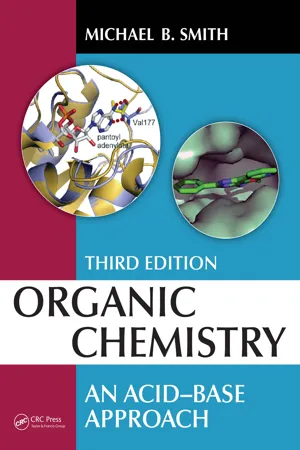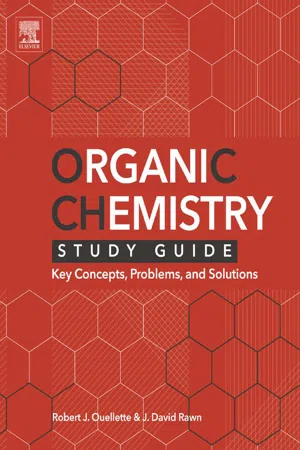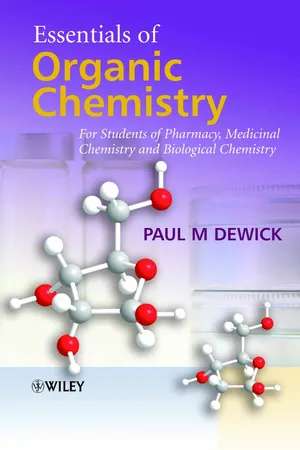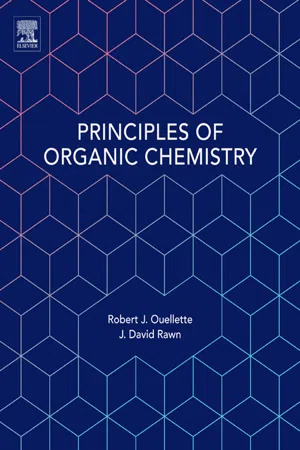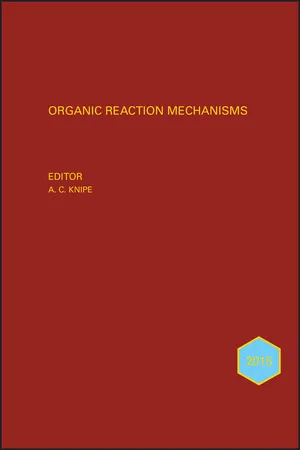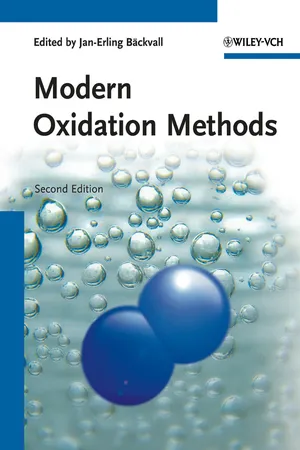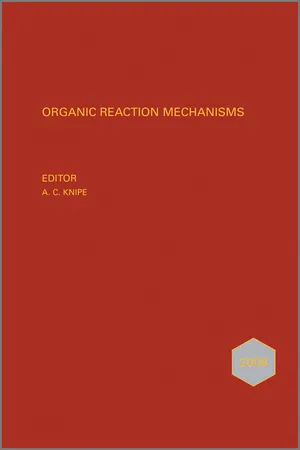Chemistry
Reactions of Aldehydes and Ketones
The reactions of aldehydes and ketones involve a variety of chemical transformations, including nucleophilic addition, oxidation, reduction, and condensation reactions. These reactions are important in organic synthesis and are used to create a wide range of compounds with diverse functional groups and properties. Aldehydes and ketones can undergo these reactions due to the presence of the carbonyl group, which is highly reactive.
Written by Perlego with AI-assistance
Related key terms
Related key terms
1 of 4
Related key terms
1 of 3
10 Key excerpts on "Reactions of Aldehydes and Ketones"
- eBook - ePub
Organic Chemistry
An Acid-Base Approach
- Michael B. Smith(Author)
- 2022(Publication Date)
- CRC Press(Publisher)
16 Reactions of Aldehydes and Ketones
DOI: 10.1201/9781003174929-16The video clips for this chapter are available at: https://routledgetextbooks.com/textbooks/9780367768706/chapter-16.phpThis chapter will discuss two major chemical Reactions of Aldehydes and Ketones. Reaction of nucleophiles with an aldehyde or ketone gives an alkoxide via acyl addition. Subsequent hydrolytic workup gives an alcohol. The carbonyl of aldehydes and ketones reacts as a Brønsted-Lowry base with a suitable acid to generate an oxocarbenium ion intermediate. This reactive intermediate will react with even weak nucleophiles.To begin this chapter, you should know the following points:- Aldehydes and ketones (Sections 5.6.2).
- π-Bonds (Section 5.1–5.3).
- Leaving groups (Section 11.2).
- Carbocations (carbenium ions) (Section 7.2.1).
- Conformations of acyclic and cyclic compounds (Sections 8.1–8.5).
- Mechanisms (Section 7.10).
- Transition states (Section 7.6).
- Alkoxides react with aqueous acid to give an alcohol (Sections 6.4 and 6.7.2).
- Grignard reagents (Sections 14.1 and 14.2).
- Organolithium reagents (Section 14.3).
- Absolute configuration (Section 9.2).
- Diastereomers (Section 9.5).
16.1 Aldehydes and Ketones
Aldehydes and Ketones and NomenclatureThe structure and nomenclature of aldehydes and ketones was introduced in Section 5.9.2. In that section, only molecules that contained a single carbonyl unit were discussed. Many molecules have two ketone units, two aldehyde units, or a ketone and an aldehyde in the same molecule. A molecule with two ketone units is a dione and a molecule with two aldehyde units is a dial. The nomenclature rules require that the longest chain must contain both carbonyl carbons. An example of a diketone is 3-heptylhexane-2,4-dione. In a cyclic diketone, both carbonyl carbons are part of the ring as in cyclohexane-1,3-dione. A dialdehyde is named as a dial, the longest chain must include both carbonyl carbons. The example shown is 2-ethyl-5-methylhexanedial. - eBook - ePub
DAT Prep Plus 2023-2024
2 Practice Tests + Proven Strategies + Online
- (Author)
- 2023(Publication Date)
- Kaplan Test Prep(Publisher)
N 2-type reactions. They can serve as the substrate for nucleophilic attack on the carbonyl to produce alcohols, ethers, amides, and related compounds. They can condense to form larger molecules and to create double bonds.Although the variety of aldehyde and ketone reaction pathways can appear overwhelming, studying them in the context of other organic molecules allows a greater understanding of the overall mechanisms involved.Synthesis of Aldehydes and Ketones
Oxidation of Alcohols
An aldehyde can be obtained from the oxidation of a primary alcohol; a ketone can be obtained from a secondary alcohol. These reactions are usually performed with PCC (one of the only options to create an aldehyde), potassium permanganate, sodium or potassium dichromate, or chromium trioxide (Jones reagent). These reactions are discussed in Chapter 45 .Figure 46.5Figure 46.6Oxidative Cleavage of Alkenes
Double bonds can be oxidatively cleaved with ozone to yield aldehydes and/or ketones (see Chapter 43 ).Ketones can also be synthesized by the cleavage of disubstituted alkenes with potassium permanganate:Figure 46.7Figure 46.8Friedel-Crafts Acylation
This reaction, discussed in Chapter 44 , produces ketones of the form R–CO–Ar from benzene and an acyl halide in the presence of a Lewis acid such as AlCl3 .Figure 46.9Reactions of Aldehydes and Ketones
Oxidation and Reduction
Aldehydes and ketones occupy the middle of the oxidation-reduction continuum. They are more oxidized than alcohols but less oxidized than carboxylic acids.Aldehydes can be oxidized with a number of different reagents, such as KMnO4 , K2 Cr2 O7 , CrO3 , Ag2 O (Tollen’s reagent), or H2 O2 - eBook - ePub
Organic Chemistry Study Guide
Key Concepts, Problems, and Solutions
- Robert J. Ouellette, J. David Rawn(Authors)
- 2014(Publication Date)
- Elsevier(Publisher)
19Aldehydes and Ketones: Nucleophilic Addition Reactions
Keys to the Chapter
The chemistry of carbonyl compounds depends on the bonding characteristics of the carbonyl group. A dipolar resonance form contributes to the carbonyl group. Much of the chemistry of carbonyl compounds involves addition of a nucleophile to the partially positive carbon atom of the carbonyl group. Aldehydes and ketones undergo addition reactions with unsymmetrical reagents such as H—Nu. The nucleophilic part of the reagent adds to the carbonyl carbon, and the electrophilic part adds to the oxygen atom. These products are obtained in both acid- and base-catalyzed reactions.19.1 Synthesis of Cyanohydrins
Hydrogen cyanide adds to an aldehyde or ketone to give a compound called a cyanohydrin . The equilibrium constant for the addition of HCN is much more favorable for aldehydes than for ketones. Thus, as we noted above, because ketones are more stable than aldehydes, the addition reactions of ketones are less favorable (have smaller equilibrium constants) than addition reactions of aldehydes.19.2 Hydration of Carbonyl Compounds
The equilibrium constant for the addition of water to a carbonyl compound is greater than one for only a few compounds such as formaldehyde. Although hydration is not a useful synthetic reaction, the equilibrium constant for hydration provides a basis for evaluating the effect of structure on carbonyl addition reactions in general.The equilibrium constants for hydration formation is greater for aldehydes than for ketones because the carbonyl carbon of an aldehyde has a greater partial positive charge than the carbonyl carbon of a ketone. Nucleophiles are attracted to a carbonyl carbon atom because of its partial positive charge. The partial positive charge is larger in an aldehyde, which has only one alkyl group bonded to the carbonyl carbon atom, than in a ketone, which has two alkyl groups. There is also a steric effect. The carbonyl carbon atom has a larger bond angle than the tetrahedral product. As a result of increased steric hindrance, the addition product is less stable for ketones than for aldehydes. - eBook - ePub
Organic Reaction Mechanisms 2012
An annual survey covering the literature dated January to December 2012
- A. C. Knipe, A. C. Knipe(Authors)
- 2015(Publication Date)
- Wiley(Publisher)
Chapter 1 Reactions of Aldehydes and Ketones and their Derivatives A.C. KnipeFaculty of Life and Health Sciences, University of Ulster, Coleraine, Northern Ireland- Formation and Reactions of Acetals and Related Species
- Reactions of Glucosides and Nucleosides
- Reactions of Ketenes and Ketenimines
- Formation and Reactions of Nitrogen Derivatives
- Imines: Synthesis, Tautomerism, and Catalysis
- The Mannich and Nitro-Mannich reactions
- Addition of organometallics
- Other alkenylations, allylations, and arylations of imines
- Oxidation and reduction of imines
- Iminium species
- Imine cycloadditions
- Other reactions of imines
- Oximes, Hydrazones, and Related Species
- C–C Bond Formation and Fission: Aldol and Related Reactions
- Reviews of Organocatalysts
- Asymmetric Aldols Catalysed by Proline, Its Derivatives, and Related Catalysts
- Other Asymmetric and Diastereoselective Aldols
- Mukaiyama and Vinylogous Aldols
- Other Aldol and Aldol-type Reactions
- The Henry (Nitroaldol) Reaction
- The Baylis–Hillman Reaction and Its Morita Variant
- Allylation and related reactions
- Alkynylations
- Michael Additions
- Miscellaneous Condensations
- Other Addition Reactions
- Addition of Organozincs
- Arylations
- Addition of Other Organometallics, Including Grignards
- The Wittig Reaction
- Hydrocyanation, Cyanosilylation, and Related Additions
- eBook - ePub
Essentials of Organic Chemistry
For Students of Pharmacy, Medicinal Chemistry and Biological Chemistry
- Paul M. Dewick(Author)
- 2013(Publication Date)
- Wiley(Publisher)
nucleophilic addition. It should be noted that the polarization in the carbonyl group leads to nucleophilic addition, whereas the lack of polarization in the C=C double bond of an alkene leads to electrophilic addition reactions (see Chapter 8). Carbonyl groups in carboxylic acid derivatives undergo a similar type of reactivity to nucleophiles, but the presence of a leaving group in these compounds leads to substitution reactions rather than addition (see Section 7.8).7.1.1 Aldehydes are more reactive than ketones
The reactions undergone by aldehydes and ketones are essentially the same, but aldehydes are more reactive than ketones. There are two rational reasons for this. Alkyl groups have an electron-donating inductive effect (see Section 4.3.3) and the presence of two such groups in ketones against just one in aldehydes means the magnitude of δ+ is reduced in ketones. Put another way, the carbonyl group in aldehydes is more electrophilic than that in ketones. It should also be noted that aromatic aldehydes, such as benzaldehyde, are less reactive than alkyl aldehydes. This is because the aromatic ring allows electron delocalization via a resonance effect that also reduces the positive charge on the carbonyl carbon.The second feature is a steric consideration. During nucleophilic addition, the planar sp 2 system of the carbonyl compound (bond angle 120°) is converted into a tetrahedral sp 3 system in the product (bond angle 109°) creating more steric crowding, i.e. the groups are brought closer together.This crowding is more severe with two alkyl substituents (from ketones) than with one alkyl and the much smaller hydrogen (from aldehydes). A consequence of this change is that the planar aldehyde or ketone can be attacked from either side of the plane with essentially equal probability. If the substituents are all different, then this will result in the creation of a chiral centre; but, since both enantiomers will be formed in equal amounts, the product will be an optically inactive racemate (assuming no other chiral centres are present in the R groups); see Section 3.4.1. - eBook - ePub
- Robert J. Ouellette, J. David Rawn(Authors)
- 2015(Publication Date)
- Elsevier(Publisher)
First, we will consider electronic effects. A ketone has two alkyl groups attached to the carbonyl carbon atom. These groups donate electron density to the carbonyl carbon atom and stabilize its partial positive charge. (We recall that alkyl groups stabilize carbocations in the same way.) The carbonyl carbon atom of an aldehyde is attached to only one alkyl group. Therefore, the carbonyl carbon atom of an aldehyde has a larger partial positive charge than that of a ketone. As a result, nucleophiles react faster with aldehydes than with ketones.The sizes of groups also affect the reactivity of aldehydes and ketones. Because a ketone has two alkyl groups attached to the carbonyl carbon atom, it is sterically hindered relative to the carbonyl carbon atom of an aldehyde, which has only a hydrogen atom and one alkyl group bonded to it. Thus, a nucleophile can approach the carbonyl group of an aldehyde more readily, so the reaction occurs faster with an aldehyde (Figure 10.3 ). Therefore, both electronic and steric effects reinforce each other to make aldehydes more reactive than ketones.Figure 10.3 Steric Effects on Addition ReactionsThe carbonyl group of an aldehyde (a) is less sterically hindered than the carbonyl group of a ketone (b). Therefore, ketones react more slowly than aldehydes in nucleophilic addition reactions. The nucleophile here is water.10.6 Synthesis of Alcohols from Carbonyl Compounds
Reactions of Aldehydes and Ketones with Grignard Reagents
In Chapter 9 we discussed the reaction of haloalkanes with magnesium to produce Grignard reagents.These reagents are used to form carbon-carbon bonds in the synthesis of complex molecules from simpler molecules. We recall that Grignard reagents contain a very strongly polarized carbon-magnesium bond in which the carbon atom has a partial negative charge.The carbon atom of the Grignard reagent resembles a carbanion. It reacts as a nucleophile and adds to the electrophilic carbon atom of a carbonyl group in an aldehyde or ketone. The magnesium ion forms a salt with the negatively charged oxygen atom. The resulting product is a magnesium alkoxide, which is hydrolyzed to obtain an alcohol.A Grignard reagent adds to various types of carbonyl compounds to give primary, secondary, and tertiary alcohols. Primary alcohols are synthesized by reacting the Grignard reagent, R—MgX, with formaldehyde. - eBook - ePub
- Andrew F. Parsons(Author)
- 2013(Publication Date)
- Wiley(Publisher)
8 Carbonyl Compounds: Aldehydes and KetonesKey point . The carbonyl (C=O) bond is polarised, and the oxygen atom is slightly negative, while the carbon atom is slightly positive. This explains the addition of nucleophiles to the carbon atom of aldehydes (RCHO) or ketones (RCOR) in nucleophilic addition reactions . A variety of charged or neutral nucleophiles can add to the carbonyl group, although addition of neutral nucleophiles usually requires the presence of an acid catalyst. Aldehydes and ketones bearing α-hydrogen atoms can undergo tautomerism to form enols or, on reaction with a base, undergo deprotonation to form enolate ions (enolates ). Enols, and particularly enolates, can act as nucleophiles and reaction with an electrophile leads to an α-substitution reaction . When an enolate reacts with an aldehyde or ketone this can produce an enone in a carbonyl-carbonyl condensation reaction .8.1 Structure
All carbonyl compounds contain an acyl fragment (RC=O) bonded to another residue. The carbonyl carbon atom is sp2 hybridised (three σ-bonds and one π-bond) and, as a consequence, the carbonyl group is planar and has bond angles of around 120°. The C=O bond is short (1.22 Å) and also rather strong (ca. 690 kJ mol−l ).Hybridisation is discussed in Section 1.5 Naming of aldehydes and ketones is discussed in Section 2.4PhCOCH3 is an aromatic ketone, CH3 COCH3 is an aliphatic ketone, and cyclohexanone, (CH2 )5 CO, is an alicyclic ketone (Section 5.1)As oxygen is more electronegative than carbon, the electrons in the C=O bond are drawn towards the oxygen. This means that carbonyl compounds are polar and have substantial dipole moments.Carbonyl compounds show characteristic peaks in the infrared (IR) and 13 C NMR spectra (see Sections 10.4 and 10.5.2). A characteristic signal is also observed for the aldehyde hydrogen, RCHO, in the 1 - eBook - ePub
Organic Reaction Mechanisms 2013
An annual survey covering the literature dated January to December 2013
- A. C. Knipe, A. C. Knipe(Authors)
- 2016(Publication Date)
- Wiley(Publisher)
Chapter 1 Reactions of Aldehydes and Ketones and Their DerivativesB. A. MurrayDepartment of Science, Institute of Technology, Tallaght (ITT Dublin), Dublin, Ireland- Formation and Reactions of Acetals and Related Species
- Reactions of Glucosides
- Reactions of Ketenes
- Formation and Reactions of Nitrogen Derivatives
- Imines: Synthesis, and General and Iminium Chemistry
- Mannich, Mannich-type and Nitro-Mannich Reactions
- Other ‘Name’ Reactions of Imines
- Synthesis of Azacyclopropanes from Imines
- Alkylations and Additions of Other C-Nucleophiles to Imines
- Arylations, Alkenylations and Allylations of Imines
- Miscellaneous Additions to Imines
- Reduction of Imines
- Other Reactions of Imines
- Oximes, Hydrazones and Related Species
- C–C Bond Formation and Fission: Aldol and Related Reactions
- Reviews of Aldols and General Reviews of Asymmetric Catalysis
- Asymmetric Aldols Catalysed by Proline and Its Derivatives
- Asymmetric Aldols Catalysed by Other Organocatalysts
- The Mukaiyama Aldol
- Other Asymmetric Aldols
- The Henry (Nitroaldol) Reaction
- The Baylis–Hillman Reaction and Its Morita-variant
- Other Aldol and Aldol-type Reactions
- Allylation and Related Reactions
- The Horner–Wadsworth–Emmons Reaction and Related Olefinations
- Alkynylations
- Stetter Reaction, Benzoin Condensation and Pinacol Coupling
- Michael Additions
- eBook - ePub
- Jan-Erling Bäckvall(Author)
- 2011(Publication Date)
- Wiley-VCH(Publisher)
10 Oxidation of Carbonyl Compounds Eric V.Johnston andJan-E. Bäckvall 10.1 IntroductionOxidation of carbonyl compounds is an important area of oxidation and involves a variety of different reaction types. This area has been reviewed by Bolm in Chapter 9 of the book ‘Modern Oxidation Methods’ (2004), and the present chapter is an update of this review. We have focused on two areas of carbonyl oxidation where important developments have occurred: (i) oxidation of aldehydes to carboxylic acids and (ii) Baeyer-Villiger oxidation.10.2 Oxidation of Aldehydes to Carboxylic AcidsThe transformation of aldehydes to carboxylic acids is a fundamental reaction in organic synthesis. Many successful methods have been developed for these types of oxidations [1], but most of them have limitations as they require stoichiometric amounts of oxidants such as chlorite [2], chromium(VI) reagents [3], potassium permanganate [4], or peroxides [5]. The use of organic solvents e.g., acetonitrile, dichloromethane, cyclohexane, formic acid, or benzene is also usually necessary. Despite the fact that these methods have several disadvantages, such as low selectivity and production of waste, some of them have been widely used in industry and are still in use today. The growing awareness of the environment has created a demand for efficient oxidation processes with environmentally friendly oxidants under mild conditions (‘green’ chemistry) [6].Molecular oxygen and hydrogen peroxide are desirable oxidants for these transformations, since they are inexpensive and environmentally friendly, with water as the only by-product. Therefore, various improved methodologies using molecular oxygen or hydrogen peroxide directly as the oxidants have been explored in recent years and reported in the literature. - eBook - ePub
Organic Reaction Mechanisms 2008
An annual survey covering the literature dated January to December 2008
- A. C. Knipe, A. C. Knipe(Authors)
- 2011(Publication Date)
- Wiley(Publisher)
6 -dimethyl KIE with respect to the perprotiated substrate. The results were interpreted in terms of the effects of steric crowding on the anharmonicity of C–H bonds in the transition structure relative to the reactant state.Oxidation ReactionsOne-pot oxidative esterification and amidation of aldehydes has been reviewed263 and an oxidative cycle has been proposed for amidation of aldehydes and alcohols with primary amines catalysed by KI-TBHP.264Baeyer-Villiger oxidation has been reviewed265 and a linear relationship between electrophilicity and Hammett σp constants has been reported for such oxidations of aromatic aldehydes and ketones.266 A mechanism has been proposed for metalloporphyrin-catalysed selective Baeyer-Villiger oxidation of ketones by molecular oxygen.267N -Heterocyclic carbenes (NHCs) have been used as organocatalysts for oxidations of aldehydes to esters promoted by the TEMPO radical268 and by alcohols (primary, secondary and tertiary).269,270 Lanthanide formamidinates have been found to be an improved class of catalysts for conversion of aldehydes to esters by the Tishchenko reaction.271Kinetic studies have explored: effects of transition ion catalysts on oxidation of benzaldehyde by bromine272 and by Ce(IV);273 the mechanism of oxidation of aromatic aldehydes by morpholinium chlorochrornate(VI);274 C–C bond cleavage in the oxidation of diketones by quinolinium dichromate;275 formation of hydrates from asymmetric and cyclic ketones in their oxidation by alkaline hexacyanoferrate(III);276 and oxidation of mannitol by Cr(IV) In acid perchlorate medium..277
Index pages curate the most relevant extracts from our library of academic textbooks. They’ve been created using an in-house natural language model (NLM), each adding context and meaning to key research topics.
Explore more topic indexes
Explore more topic indexes
1 of 6
Explore more topic indexes
1 of 4
